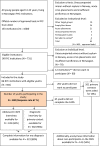Prevalence and comorbidity of mental disorders among adolescents living in residential youth care
- PMID: 25749933
- PMCID: PMC4698296
- DOI: 10.1007/s00787-015-0700-x
Prevalence and comorbidity of mental disorders among adolescents living in residential youth care
Abstract
Most adolescents are placed in residential youth care (RYC) because of severe psychosocial strains and child maltreatment, which represent risk factors for developing mental disorders. To plan RYC units and ensure that residents receive evidence-based psychiatric interventions, it is necessary to obtain reliable and valid prevalence estimates of mental disorders in this population. However, there is a lacuna of research on diagnoses derived from standardized clinical interviews. The aim of this study was to assess the prevalence and comorbidity of mental disorders applying diagnostic interviews in an entire population of adolescents living in RYC in Norway. All young people in RYC were invited to participate in the study. Eighty-six RYC institutions with 601 eligible adolescents were included and 400 adolescents, 12-20 years old, participated in the study, yielding a response rate of 67 %. Anonymous Child Behaviour Checklist scores for 141 (70 %) of the declining residents were also available, allowing diagnoses according to the Diagnostic and Statistical Manual of Mental Disorders Fourth Edition (DSM-IV) for 541 youths to be estimated. Diagnoses were assessed by trained interviewers with the Child and Adolescent Psychiatric Assessment interview (CAPA). Seventy-six point two per cent (71.5-80.8 CI 95 %) of adolescents received at least one 3-month DSM-IV diagnosis. Prevalence rates for internalizing psychiatric disorders were higher than for behavioural disorders. Comorbidity was high between these two groups. Mental disorders were prevalent among children and youth in RYC. Our results create major concerns and challenge the existing organization of the RYC system.
Keywords: Adolescents; CAPA; Comorbidity; Mental disorders; Prevalence; Residential youth care.
Figures

Similar articles
-
Self- and proxy reports of quality of life among adolescents living in residential youth care compared to adolescents in the general population and mental health services.Health Qual Life Outcomes. 2015 Jul 22;13:104. doi: 10.1186/s12955-015-0280-y. Health Qual Life Outcomes. 2015. PMID: 26197764 Free PMC article.
-
Child maltreatment and quality of life: a study of adolescents in residential care.Health Qual Life Outcomes. 2016 May 10;14:74. doi: 10.1186/s12955-016-0479-6. Health Qual Life Outcomes. 2016. PMID: 27161357 Free PMC article.
-
Previous maltreatment and present mental health in a high-risk adolescent population.Child Abuse Negl. 2015 Jul;45:122-34. doi: 10.1016/j.chiabu.2015.05.003. Epub 2015 May 21. Child Abuse Negl. 2015. PMID: 26003821
-
Adolescent substance abuse and psychiatric comorbidities.J Clin Psychiatry. 2006;67 Suppl 7:18-23. J Clin Psychiatry. 2006. PMID: 16961420 Review.
-
Prevalence estimates of mental health problems in children and adolescents with intellectual disability: A systematic review and meta-analysis.Aust N Z J Psychiatry. 2020 Oct;54(10):970-984. doi: 10.1177/0004867420924101. Epub 2020 May 30. Aust N Z J Psychiatry. 2020. PMID: 32475125
Cited by
-
Screening for more with less: Validation of the Global Appraisal of Individual Needs Quick v3 (GAIN-Q3) screeners.J Subst Abuse Treat. 2021 Jul;126:108414. doi: 10.1016/j.jsat.2021.108414. Epub 2021 Apr 15. J Subst Abuse Treat. 2021. PMID: 34116811 Free PMC article.
-
Prevalence and correlates of post-traumatic stress disorder and depression among welfare- and justice-involved adolescents in Nigeria.Eur J Psychotraumatol. 2024;15(1):2434316. doi: 10.1080/20008066.2024.2434316. Epub 2024 Dec 18. Eur J Psychotraumatol. 2024. PMID: 39691078 Free PMC article.
-
Lifetime Contacts with Child Welfare Services among Children and Adolescents with ADHD: A Population-Based Registry Study.Child Psychiatry Hum Dev. 2025 May 28. doi: 10.1007/s10578-025-01857-9. Online ahead of print. Child Psychiatry Hum Dev. 2025. PMID: 40434614
-
Self- and proxy reports of quality of life among adolescents living in residential youth care compared to adolescents in the general population and mental health services.Health Qual Life Outcomes. 2015 Jul 22;13:104. doi: 10.1186/s12955-015-0280-y. Health Qual Life Outcomes. 2015. PMID: 26197764 Free PMC article.
-
Personal Stories of Young Women in Residential Care: Health-Promoting Strategies and Wellbeing.Int J Environ Res Public Health. 2022 Dec 7;19(24):16386. doi: 10.3390/ijerph192416386. Int J Environ Res Public Health. 2022. PMID: 36554265 Free PMC article.
References
-
- Green JG, McLaughlin KA, Berglund PA, Gruber MJ, Sampson NA, Zaslavsky AM, Kessler RC. Childhood adversities and adult psychiatric disorders in the national comorbidity survey replication I: associations with first onset of DSM-IV disorders. Arch Gen Psychiatr. 2010;67(2):113–123. doi: 10.1001/archgenpsychiatry.2009.186. - DOI - PMC - PubMed
-
- Backe-Hansen E, Bakketeigen E, Gautun H, AB. G (2011) Institusjonsplassering—siste utvei. Betydningen av barnevernsreformen fra 2004 for institusjonstilbudet. (Placement in institutions—the last opportunity. The importance of the child welfare reform in 2004 for placement policy in institutions.) NOVA—Norsk institutt for forskning om oppvekst, velferd og aldring
-
- Berridge D. Theory and explanation in child welfare: education and looked-after children. Child Family Soc Work. 2007;12(1):1–10. doi: 10.1111/j.1365-2206.2006.00446.x. - DOI
-
- Vinnerljung B, Oman M, Gunnarson T. Educational attainments of former child welfare clients—a Swedish national cohort study. Int J Soc Welf. 2005;14(4):265–276. doi: 10.1111/j.1369-6866.2005.00369.x. - DOI
Publication types
MeSH terms
LinkOut - more resources
Full Text Sources
Other Literature Sources
Medical

